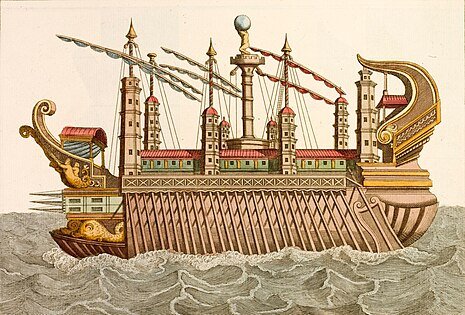Definition
- Strategies for innovation are various techniques or phenomena that allow or push for innovation.
- Designers have a range of strategies for innovation.
Act of Insight
- Often referred to as the “eureka moment”, a sudden image of a potential solution is formed in the mind, usually after a period of thinking about a problem.
Example
- Archimedes first discovered the law of buoyancy while taking a bath, after noticing the rise in water level. The discovery allow him to design the giant transport ship Syracusia.

Adaptation
- A solution to a problem in one field is used to provide a new idea for a design problem in another field.
Example
- The principle of how a hovercraft works was adapted by the designers of the hover lawn mower.
Analogy
- An idea from one context is used to stimulate ideas for solving a problem in another context.
Example
- Sonar modelled on how bats and whales navigate using echolocation.
Chance Discovery
- An unexpected discovery leads to a new idea.
Example
- Velcro was developed when George de Mestral was walking with his dog found lots of seed pods stuck to his socks and dog.
- He looked under the microscope and made his discovery of the pods having many little hooks, which he adapted into Velcro.
- Percy Spencer, an engineer with the Raytheon Corporation was conducting a radar-related research project with a new vacuum tube.
- Spencer realized that the candy bar in his pocket began to melt during his experiments. He then put popcorn into the machine, and when it started to pop, he knew he had a revolutionary device on his hands.
Market Pull
- A new idea is needed as a result of demand from the marketplace.
Example
- The car market which has separate segments for the supermini, family cars, mini-vans, executive cars, sports cars, SUV, and so on.
Technology Push
- Scientific research leads to advances in technology that underpin new ideas.
Example
- The Sony Walkman is an example.
Technology Transfer
- Technological advances that form the basis of new designs may be applied to the development of different types of products and systems.
Example
- Laser transferred into surgery or audio or data CDs.
Research and Development
- Companies encourage advancements in technology and services, usually by investing in research and development (R&D) activities.
- Even though the R&D may be carried out by a range of different experts from varied fields of research, the development process is often based on common principles and strategies to identify the direction of development.
- This methodology structures the R&D of new technologies and services.
- Innovation should always occur in context and a deep understanding of the culture as well as the behaviors, needs and wants of the consumer is required.
Sources
https://commons.wikimedia.org/wiki/File:Depiction_of_Syracosia_by_N_Witsen.jpg